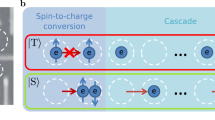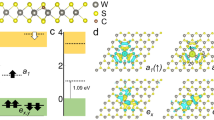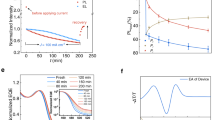Abstract
Coulomb interactions between electrons lead to the observed multiplet structure and breakdown of the Aufbau principle for atomic d and f shells1. Nevertheless, these effects can disappear in extended systems. For instance, the multiplet structure of atomic carbon is not a feature of graphite or diamond. A quantum dot is an extended system containing ∼106 atoms for which electron–electron interactions do survive and the interplay between the Coulomb energy, J, and the quantization energy, ΔE, is crucial to Coulomb blockade2,3,4,5. We have discovered consequences of Coulomb interactions in self-assembled quantum dots by interpreting experimental spectra with an atomistic calculation. The Coulomb effects, evident in the photon emission process, are tunable in situ by controlling the quantum dot charge from +6e to −6e. The same dot shows two regimes: J≤ΔE for electron charging yet J≃ΔE for hole charging. We find a breakdown of the Aufbau principle for holes; clear proof of non-perturbative hole–hole interactions; promotion–demotion processes in the final state of the emission process, effects first predicted a decade ago6; and pronounced configuration hybridizations in the initial state. The level of charge control and the energy scales result in Coulomb effects with no obvious analogues in atomic physics.
This is a preview of subscription content, access via your institution
Access options
Subscribe to this journal
Receive 12 print issues and online access
$259.00 per year
only $21.58 per issue
Buy this article
- Purchase on SpringerLink
- Instant access to full article PDF
Prices may be subject to local taxes which are calculated during checkout




Similar content being viewed by others
References
Goeppert Mayer, M. Rare-earth and transuranic elements. Phys. Rev. 60, 184–187 (1941).
Yacoby, A., Heiblum, M., Mahalu, D. & Shtrikman, H. Coherence and phase sensitive measurements in a quantum dot. Phys. Rev. Lett. 74, 4047–4050 (1995).
Tarucha, S., Austing, D. G., Tokura, Y., van der Wiel, W. G. & Kouwenhoven, L. P. Direct Coulomb and exchange interaction in artificial atoms. Phys. Rev. Lett. 84, 2485–2488 (2000).
Miller, B. T. et al. Few-electron ground states of charge-tunable self-assembled quantum dots. Phys. Rev. B 56, 6764–6769 (1997).
Reuter, D. et al. Coulomb-interaction-induced incomplete shell filling in the hole system of InAs quantum dots. Phys. Rev. Lett. 94, 026808 (2005).
Wojs, A. & Hawrylak, P. Theory of photoluminescence from modulation-doped self-assembled quantum dots in a magnetic field. Phys. Rev. B 55, 13066–13071 (1997).
Warburton, R. J. et al. Optical emission from a charge-tunable quantum ring. Nature 405, 926–929 (2000).
Bayer, M. et al. Fine structure of neutral and charged excitons in self-assembled In(Ga)As/(Al)GaAs quantum dots. Phys. Rev. B 65, 195315 (2002).
Finley, J. J. et al. Quantum-confined Stark shifts of charged exciton complexes in quantum dots. Phys. Rev. B 70, 201308(R) (2004).
Wang, L.-W. & Zunger, A. Linear combination of bulk bands method for large-scale electronic structure calculations on strained nanostructures. Phys. Rev. B 59, 15806–15818 (1999).
Bester, G., Wu, X., Vanderbilt, D. & Zunger, A. Importance of second-order piezoelectric effects in zinc-blende semiconductors. Phys. Rev. Lett. 96, 187602 (2006).
Shumway, J., Franceschetti, A. & Zunger, A. Correlation versus mean-field contributions to excitons, multiexcitons, and charging energies in semiconductor quantum dots. Phys. Rev. B 63, 155316 (2001).
Resta, R. Thomas–Fermi dielectric screening in semiconductors. Phys. Rev. B 16, 2717–2722 (1977).
Franceschetti, A., Wang, L.-W., Fu, H. & Zunger, A. Short-range versus long-range electron–hole exchange interactions in semiconductor quantum dots. Phys. Rev. B 58, R13367–R13370 (1998).
He, L., Bester, G. & Zunger, A. Electronic phase diagrams of carriers in self-assembled quantum dots: Violation of Hund’s rule and the Aufbau principle for holes. Phys. Rev. Lett. 95, 246804 (2005).
Ediger, M. et al. Fine structure of negatively and positively charged excitons in semiconductor quantum dots: Electron–hole asymmetry. Phys. Rev. Lett. 98, 036808 (2007).
Bester, G. & Zunger, A. Compositional and size-dependent spectroscopic shifts in charged self-assembled InxGa1−xAs/GaAs quantum dots. Phys. Rev. B 68, 073309 (2003).
Warburton, R. J. et al. Coulomb interactions in small charge-tunable quantum dots: A simple model. Phys. Rev. B 58, 16221–16231 (1998).
Karrai, K. et al. Hybridization of electronic states in quantum dots through photon emission. Nature 427, 135–138 (2004).
Acknowledgements
The work was supported by EPSRC (UK), US Department of Energy SC-BES under Contract No. DE-AC36-99GO10337 LAB-03-17, DAAD and SFB 631 (Germany) and SANDiE (EU).
Author information
Authors and Affiliations
Contributions
M.E. carried out the experimental work under the supervision of R.J.W. and K.K; G.B. carried out the theoretical work in A.Z.’s group; A.B. fabricated the heterostructure in P.M.P.’s group. M.E., G.B., K.K., A.Z. and R.J.W. worked jointly on the interpretation of the results.
Corresponding authors
Supplementary information
Rights and permissions
About this article
Cite this article
Ediger, M., Bester, G., Badolato, A. et al. Peculiar many-body effects revealed in the spectroscopy of highly charged quantum dots. Nature Phys 3, 774–779 (2007). https://doi.org/10.1038/nphys748
Received:
Accepted:
Published:
Issue date:
DOI: https://doi.org/10.1038/nphys748
This article is cited by
-
Dual-resonance enhanced quantum light-matter interactions in deterministically coupled quantum-dot-micropillars
Light: Science & Applications (2021)
-
Inverse design in search of materials with target functionalities
Nature Reviews Chemistry (2018)
-
Absence of redshift in the direct bandgap of silicon nanocrystals with reduced size
Nature Nanotechnology (2017)
-
All-Optical Fiber Hanbury Brown & Twiss Interferometer to study 1300 nm single photon emission of a metamorphic InAs Quantum Dot
Scientific Reports (2016)
-
Coherent photocurrent spectroscopy of single InP-based quantum dots in the telecom band at 1.5 µm
Applied Physics B (2016)



